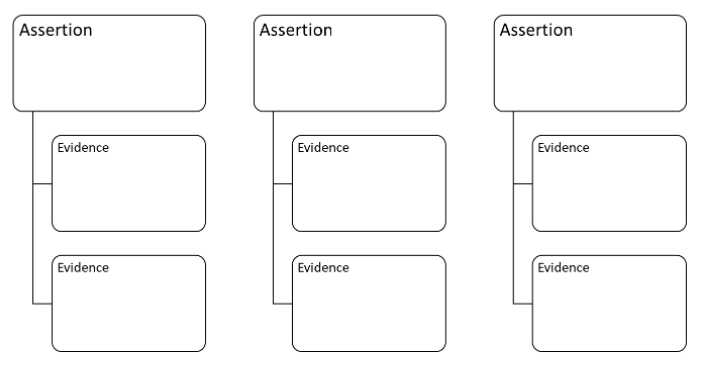Dana Dawson

The Advance Organizer is a tool you can use to focus student attention during lectures, improve retention of course content and connect new information with prior knowledge. Advanced Organizers can take a variety of forms from brief expository overviews to help students make meaning of course content to graphic representations that provide a framework for information.
Overview
As an expert in your field, it can be hard to put yourself in the shoes of someone new to the information you’re sharing. The connections between content delivered in separate lessons, how a theory applies to a specific case or even the meaning of frequently used terms in your discipline may seem so obvious to you that they don’t require explicit explanation for your students. Ambrose et. al. point out that one important way in which expert and novice learners differ is in the density of connections among concepts, facts and skills. Research on learning has shown that students retain more of what they learn and for longer if they connect new information with prior knowledge and have an organizational schema, or knowledge structure within which to fit new information.
In addition to giving students a framework within which to fit new information, Advance Organizers help students focus during lectures, whether given in-person or delivered in a pre-recorded format. The duration of a student’s attention span will vary for a variety of reasons, but research suggests that we should anticipate attention lapses and intersperse listening to videos or lectures with frequent activities to bring attention back to the content, integrate low stakes opportunities for students to self-assess understanding and highlight key points and takeaways.
Types and Examples
Expository organizers are used primarily for new and unfamiliar learning material. For example, Dee Ann Gillies tested the use of expository organizers in the form of short statements outlining unifying concepts related to information presented during lectures with students enrolled in an introductory course in medical surgical nursing. The study found improved learning and short-term retention of material.
Narrative organizers use a story structure to convey information. A story might illustrate something about course content through analogy or by turning key concepts into characters and building detail and narrative to help students recall key information (see, for example, Sketchy’s study guides sketchy.com).
Know-Wonder-Learn (KWL) is an advanced organizer that helps both instructor and student access background knowledge. Students are asked to complete the first two columns prior to instruction and to share what they have written. The final column can be filled in for reflection or submission.

(https://teaching.vt.edu/content/dam/teaching_vt_edu/resources/Advance%20Organizers.pdf)
Graphic organizers constitute the biggest category of Advance Organizers and can take a wide variety of forms, including tables, venn diagrams, flow charts and concept maps. They can be used to help students see connections between concepts, the steps in a process or sequence of events or simply to organize students’ thinking before, during or after instruction.
Examples:

(Barkley, Elizabeth F.. Interactive Lecturing: A Handbook for College Faculty, John Wiley & Sons, Incorporated, 2018: 242. ProQuest Ebook Central, https://ebookcentral.proquest.com/lib/templeuniv-ebooks/detail.action?docID=5254245.)


Implementation
Advance Organizers can be distributed in completed form or as blank documents that students complete before, during or after instruction. The SmartArt options in PowerPoint are helpful for creating graphic organizers that suit your specific needs. You might assign students to work in pairs or small groups to complete the Advance Organizer or compare notes. They also can be used in your syllabus or Canvas course to provide students with an overview of the material to come. For additional information on the use of graphic organizers in syllabi, review the CAT workshop recording of The Interactive and Graphic Syllabus here.
Additional Resources
- Ambrose, S. A., Bridges, M. W., DiPietro, M., Lovett, M., Norman, M. K., & Mayer, R. E. (2010). How Learning Works: Seven Research-Based Principles for Smart Teaching. Jon Wiley & Sons, Incorporated.
- Barkley, E. F. (2018). Interactive Lecturing: A Handbook for College Faculty. John Wiley & Sons, Incorporated.
- Center for Excellence in Teaching and Learning, Virginia Tech. Advance Organizers. https://teaching.vt.edu/content/dam/teaching_vt_edu/resources/Advance%20Organizers.pdf
- College Star. Advance Organizers: Preparing Students for Learning. https://www.collegestar.org/modules/advance-organizers#jafari-2012
- Costley, J., Mik, F., Lange, C., & Baldwin, M. (2021). The effects of video lecture viewing strategies on cognitive load. Journal of Computing in Higher Education, 33(1), 19-38. http://dx.doi.org/10.1007/s12528-020-09254-y
- Creately. The Ultimate List of Graphic Organizers for Teachers and Students. https://creately.com/blog/diagrams/types-of-graphic-organizers/
- Gillies, D.A. (1984). Effect of advance organizers on learning medical surgical nursing content by baccalaureate nursing students. Research in Nursing and Health, 7, 173-180. https://doi-org.libproxy.temple.edu/10.1002/nur.4770070305
- Jafari, K. & Hashim, F. (2012) The effects of using advance organizers on improving EFL learners’ listening comprehension: A mixed method study. System, 40(2), 270-281. https://doi.org/10.1016/j.system.2012.04.009.
- Learnet. What is an Advanced Organizer? http://www.projectlearnet.org/tutorials/advance_organizers.html
- Luiten, J., Ames, W., & Ackerson, G. (1980). A meta-analysis of the effects of advance organizers on learning and retention. American Educational Research Journal, 17(2), 211–218. https://doi.org/10.2307/1162483
- Patricia Cross Academy. Learning Technique 29: Advance Organizers. https://kpcrossacademy.org/techniques/advance-organizers/
Dana Dawson is Associate Director of Temple University’s Center for the Advancement of Teaching.